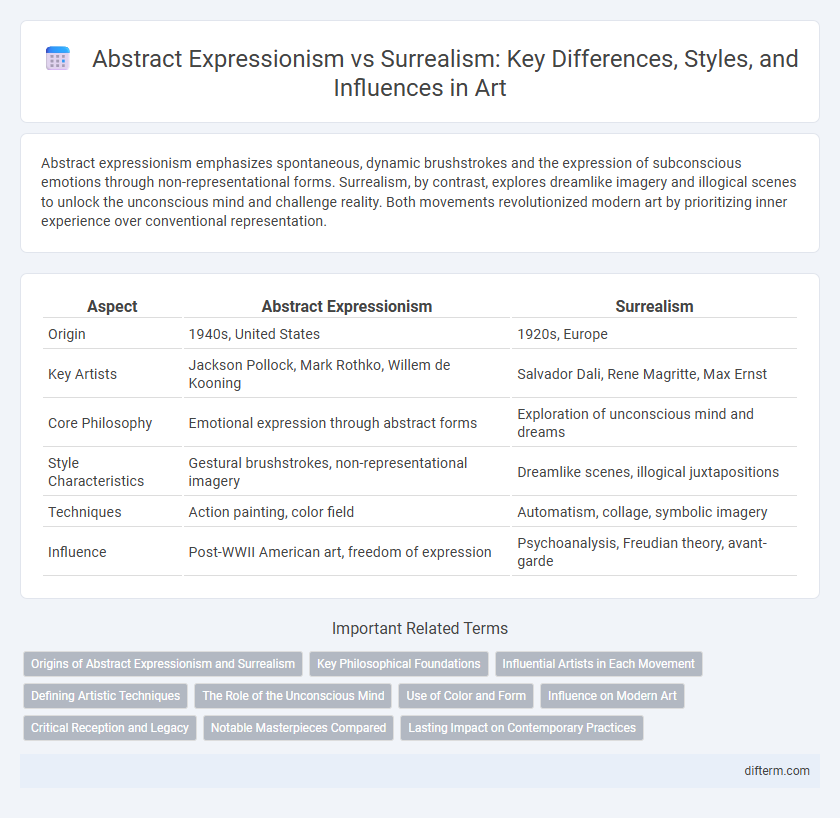Abstract expressionism emphasizes spontaneous, dynamic brushstrokes and the expression of subconscious emotions through non-representational forms. Surrealism, by contrast, explores dreamlike imagery and illogical scenes to unlock the unconscious mind and challenge reality. Both movements revolutionized modern art by prioritizing inner experience over conventional representation.
Table of Comparison
| Aspect | Abstract Expressionism | Surrealism |
|---|---|---|
| Origin | 1940s, United States | 1920s, Europe |
| Key Artists | Jackson Pollock, Mark Rothko, Willem de Kooning | Salvador Dali, Rene Magritte, Max Ernst |
| Core Philosophy | Emotional expression through abstract forms | Exploration of unconscious mind and dreams |
| Style Characteristics | Gestural brushstrokes, non-representational imagery | Dreamlike scenes, illogical juxtapositions |
| Techniques | Action painting, color field | Automatism, collage, symbolic imagery |
| Influence | Post-WWII American art, freedom of expression | Psychoanalysis, Freudian theory, avant-garde |
Origins of Abstract Expressionism and Surrealism
Abstract Expressionism emerged in the 1940s in New York City, rooted in the post-World War II American cultural climate and influenced by European modernist movements and the psychological theories of Carl Jung. Surrealism originated in the early 1920s in Paris, founded by Andre Breton, emphasizing the exploration of the unconscious mind through dream imagery and automatism, heavily inspired by Freudian psychoanalysis. Both movements sought to break traditional artistic boundaries but diverged in their methods, with Abstract Expressionism focusing on spontaneous, gestural brushstrokes and Surrealism prioritizing symbolic, dream-like visuals.
Key Philosophical Foundations
Abstract Expressionism emphasizes spontaneous, subconscious creation, rooted in existential philosophy and the belief in individual freedom and emotional intensity. Surrealism is grounded in psychoanalytic theory, particularly Freud's ideas, aiming to unlock the unconscious mind through dreams and irrational juxtapositions. Both movements challenge traditional realism, but Abstract Expressionism prioritizes personal expression, while Surrealism explores symbolic narratives from the unconscious.
Influential Artists in Each Movement
Jackson Pollock and Mark Rothko defined Abstract Expressionism through dynamic brushstrokes and color fields, shaping post-war American art. Salvador Dali and Rene Magritte led Surrealism by exploring dreamscapes and the unconscious mind with striking, bizarre imagery. These influential artists each transformed modern art by challenging traditional perceptions and emphasizing emotional and psychological depth.
Defining Artistic Techniques
Abstract Expressionism emphasizes spontaneous, dynamic brushwork and the physical act of painting, often highlighting color field and gestural abstraction to evoke emotional intensity. Surrealism relies on techniques like automatism, dream imagery, and unexpected juxtapositions to explore the unconscious mind and irrational scenes. The key artistic methods in Abstract Expressionism manifest through energetic, non-representational forms, whereas Surrealism employs symbolic, illogical compositions rooted in psychoanalytic theory.
The Role of the Unconscious Mind
Abstract expressionism channels the unconscious mind through spontaneous, gestural brushstrokes that emphasize raw emotion and personal intuition. Surrealism, by contrast, delves into the unconscious to reveal dreamlike imagery and illogical scenes inspired by psychoanalytic theories, particularly those of Freud. Both movements prioritize the unconscious, yet abstract expressionism manifests it via abstraction and physicality, while surrealism translates it into symbolic, fantastical visuals.
Use of Color and Form
Abstract expressionism emphasizes spontaneous, bold brushstrokes with vivid, dynamic color palettes to convey emotional intensity, often abandoning recognizable forms. Surrealism utilizes dreamlike imagery and symbolic forms with precise, often muted colors to explore the subconscious mind and fantasy. Both movements manipulate color and form uniquely to evoke psychological and emotional responses but diverge in their approach to abstraction versus representational illusion.
Influence on Modern Art
Abstract Expressionism revolutionized modern art by emphasizing spontaneous, subconscious creation, influencing artists to explore emotional intensity and individual expression through bold colors and dynamic brushstrokes. Surrealism contributed by introducing dreamlike imagery and the exploration of the unconscious mind, inspiring modern artists to experiment with symbolism and irrational juxtapositions. Both movements challenged traditional aesthetics, expanding the boundaries of artistic creativity and shaping contemporary art's focus on personal and psychological depth.
Critical Reception and Legacy
Abstract expressionism received critical acclaim for its emphasis on spontaneous, emotional intensity and large-scale compositions that reshaped postwar American art. Surrealism was celebrated for its imaginative exploration of the subconscious and dream imagery, influencing diverse artistic disciplines and popular culture worldwide. Both movements left enduring legacies; abstract expressionism established New York as a global art center, while surrealism profoundly impacted literature, film, and visual arts through its exploration of the unconscious mind.
Notable Masterpieces Compared
Jackson Pollock's "No. 5, 1948" exemplifies Abstract Expressionism through its dynamic drip painting technique, emphasizing spontaneous, subconscious creation. In contrast, Salvador Dali's "The Persistence of Memory" represents Surrealism with its dreamlike imagery and meticulous detail, exploring the unconscious mind and distorted reality. Both masterpieces highlight divergent artistic approaches: Abstract Expressionism's focus on emotional intensity versus Surrealism's narrative of fantastical symbolism.
Lasting Impact on Contemporary Practices
Abstract expressionism revolutionized contemporary art by emphasizing spontaneous, emotive brushwork and large-scale canvases, influencing modern practices in performance art and mixed media. Surrealism's impact is evident in contemporary visual narratives and digital art through its exploration of the subconscious, dream imagery, and unexpected juxtapositions. Both movements continue to inspire artists to challenge conventional representation and explore innovative creative processes.
abstract expressionism vs surrealism Infographic

 difterm.com
difterm.com